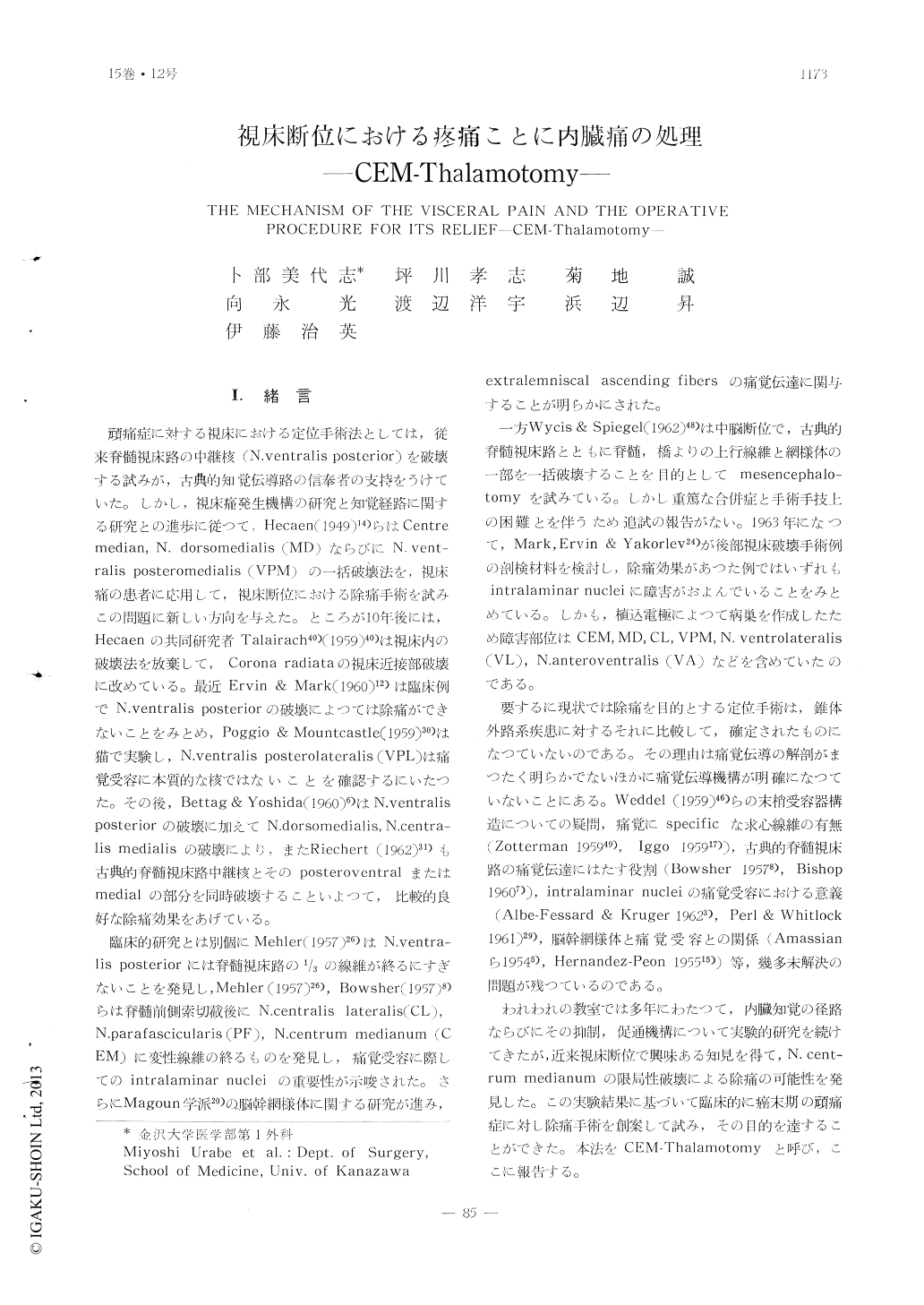Japanese
English
- 有料閲覧
- Abstract 文献概要
- 1ページ目 Look Inside
I.緒言
頑痛症に対する視床における定位手術法としては,従来脊髄視床路の中継核(N. ventralis posterior)を破壊する試みが,古典的知覚伝導路の信奉者の支持をうけていた。しかし,視床痛発生機構の研究と知覚経路に関する研究との進歩に従つて,Hecaen (1949)14)らはCentre median, N. dorsomedialis (MD)ならびにN. vent—ralis posteromedialis (VPM)の一括破壊法を,視床痛の患者に応用して,視床断位における除痛手術を試みこの問題に新しい方向を与えた。ところが10年後には,Hecaenの共同研究者Talairach40)(1959)40)は視床内の破壊法を放棄して,Corona radiataの視床近接部破壌に改めている。最近Ervin & Mark (1960)12)は臨床例でN. ventralis posteriorの破壊によつては除痛ができないことをみとめ,Poggio & Mountcastle (1959)30)は猫で実験し,N. ventralis posterolateralis (VPL)は痛覚受容に本質的な核ではないことを確認するにいたつた。その後,Bettag & Yoshida (1960)6)はN. ventralis posteriorの破壊に加えてN. dorsomedialis, N. centra—lis medialisの破壊により、またRiechert (1962)31)も古典的脊髄視床路中継核とそのposteroventralまたはmedialの部分を同時破壊することいよつて,比較的良好な除痛効果をあげている。
臨床的研究とは別個にMehler (1957)26)はN. ventra—lis posteriorには脊髄視床路の1/3の線維が終るにすぎないことを発見し,Mehler (1957)26), Bowsher (1957)8)らは脊髄前側索切截後にN. centralis lateralis (CL), N. parafascicularis (PF), N. centrum medianum (CEM)に変性線維の終るものを発見し,痛覚受容に際してのintralaminar nucleiの重要性が示唆された。さらにMagoun学派20)の脳幹網様体に関する研究が進み,extralemniscal ascending fibersの痛覚伝達に関与することが明らかにされた。
The evoked potentials were recorded from N. ventralis posterolateralis (VPL), magnocellular part of Corpus geniculatum mediale (MGmc) and N. centrum medianum (CEM) in the tha-lamic level following the stimulation of the proximal end of the divided splanchnic, as well as, sciatic nerves. From the observation of the potentials, CEM did not show somato-topic representation in the receptive field of the sensory paths. On the evoked potential from CEM, the post-tetanic occlusion was seen and a particular type of the spindle burst appeared following the tetanic stimulation of the splanchnic nerve. The same type of the spindle burst appeared also on the potentials from CEM after an application of strychnine to the frontal cortex. The recruiting response was seen in the cortical EEG by the stimula-tion of CEM. CEM was regarded as a region where the convergence occurred in the afferent transmission of pain from both the splanchnic and sciatic nerves, and the spontaneous acti-vities of CEM changed to spidle bursts fol-lowing tetanic stimulation of the splanchnic nerve and strychnization of frontal cortex. According to these results, it is suggested that the reverberating circuit from the thala-mus to the cortex, making a focus in CEM, played an important role in the sensation of pain. On the other hand, the neuron activity in the reticular formation of the mid-brain which was responsible for the noxious stimuli is facilitated by the stimulation of CEM.
Based on the experimental results, the de-struction of CEM should result in the relief of the visceral pain. The authors have devised a stereotaxic operation to make a circum-scribed lesion in CEM for relief of pain. The treatment was done in 5 cases of the intract-able pain by the advanced malignant tumor and one case of intermedial neuralgia. The striking effect was observed in all the cases, showing a complete and continuous relief of pain sensation alone, without any impairment of other sensation and without any disturb-ance of defecation and micturition. The con-sciousness was not influenced by the surgical intervention. No any fatal complication else was experienced.

Copyright © 1963, Igaku-Shoin Ltd. All rights reserved.


